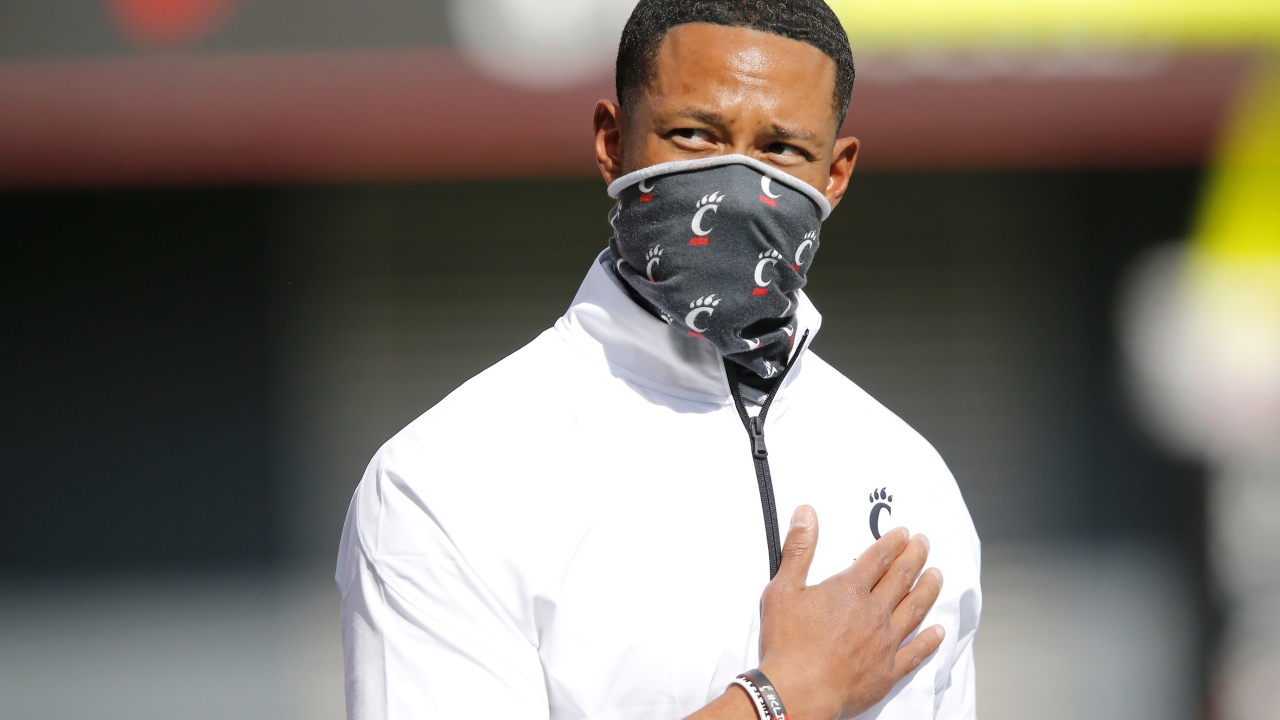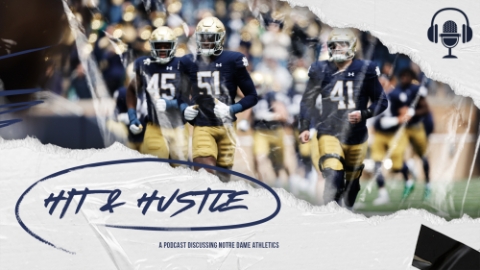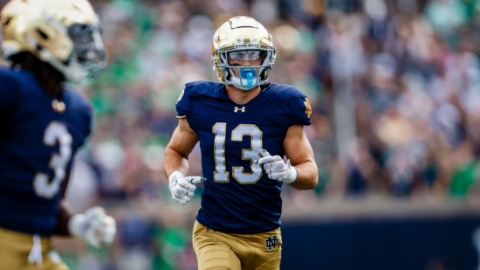
At the end of 2016, Brian Kelly had a critical hire to make a defensive coordinator. He wasn’t exactly in a position of strength at the time, though.
Coming off a 4-8 season, his name was at the top of every hot seat list. You could forgive any coach for not wanting to sprint to sign a contract to be on his staff at that time, which is part of the reason why he ended up with then Wake Forest defensive coordinator Mike Elko.
He wasn’t the most high profile hire. He was simply a good one, which was exactly what Kelly and Notre Dame needed.
The program is in a much different position than it was then.
They’ve won 10 or more games in four straight seasons. Two of the last three years they made the College Football Playoff. With what they’ve done recently, Kelly had a greater opportunity to hire a more sought after defensive coordinator candidate.
Mission accomplished with the addition of former Cincinnati defensive coordinator Marcus Freeman to the staff.
Fans are excited because they know he was the top of the board DC target. They should be just as excited about his scheme and the way he utilizes his personnel.
3-3-5 because of the offenses he faced in the AAC
Freeman ran a 3-3-5 for most of the last two seasons primarily because of the types of offenses he regularly faced in the AAC. It’s a lot like the Big 12 with it being a wide open league.
There are Air Raid teams (Houston and SMU), veer n’ shoot teams (UCF and previously USF), an RPO heavy (Memphis), and a power spread team (Tulane). With all of that, playing a 3-3-5 made a lot of sense and also fit really well with the personnel for Cincinnati.
Freeman broke out the defense against UCF in 2019. They held Josh Heupel’s offense to 4.84 yards per play, their lowest average of the season. That offense finished 8th in YPP with 6.92 that season.
I’m sure Notre Dame fans think of Iowa State when they hear 3-3-5, but the defenses are different. Iowa State plays a lot more with three high safeties (something Notre Dame has done over the last couple of seasons). Cincinnati is, as The Draft Network’s Benjamin Solak points out in this piece about Freeman’s defense, different than Iowa State because of mixing up the depth of defenders away from the line of scrimmage and the level of confusion that causes.
There’s a lot more disguise and attack.
Solak wrote, “Freeman’s defense contests everything. They blitz, they spin, they rush gaps, they twist and stunt. They don’t want to limit big plays by dropping their three safeties deep—they want to use them to create TFLs, hurry throws, hit quarterbacks, and generate turnovers.”
That really describes it well.
They also weren’t an exclusively three down team. They ran four down (4-2-5), would use a two down look, and change up alignments often.
I believe we’ll see Freeman play four down a lot more with Notre Dame’s personnel, but 3-3-5 is something I would expect to see a fair amount of too. Being multiple is important and that is what I expect this new Notre Dame defense to be.
Consistently great run defense
Probably what impressed me the most about Freeman was watching his defense play the run. They did things to confuse blocking schemes with pre-snap and post-snap movement that allowed their defenders to thrive.
Georgia had a clear advantage against them up front, yet they only averaged 1.9 yards per carry. Cincinnati stemmed the defensive line late and continually slanted up front to disrupt the line of scrimmage.
Freeman would move linebackers to mug up and show a four man front with three down, but play with it enough times that offensive lines wouldn’t get a beat on it. Even against tempo, they would constantly show different alignments up front and vary them from play to play.
With three down, they wouldn’t stay static and it was a one-gap scheme. It gives defensive linemen opportunities to make plays and that’s all those guys want. There isn’t a constant ask of them to two-gap and hold the point so linebackers can clean up.
He’ll run blitz with outside defenders like he does here against Georgia.
The overhang defenders play a big role in shutting down the run they are often unblocked and get to make plays like this because offenses believe they have numbers to run successfully when they don’t. That pulling guard should be coming out to attack the outside linebacker, but his eyes are inside the whole time.
Cincinnati had an 18.9% Havoc Rate in 2018, an 18.3% in 2019 and were at 19.4% last season. That was top-20 in the country each of the last three years and a lot of it was about not letting blocking schemes get comfortable with what Freeman was showing them.
Adapt each week
I know some Notre Dame fans saw Jon Tenuta as a defensive analyst at Cincinnati and had unsettling flashbacks to the end of the Charlie Weis era. Those fans can rest easy as Freeman isn’t anything closet to Tenuta in terms of falling in love with the blitz.
Yes, the defense attacks. It also adjusts to who they are facing from week to week.
Freeman blitzed starting quarterbacks only 28.4% of the time last season. That’s not a high number and the reason it isn’t has to do with how Freeman, smartly, called games against certain offenses.
When playing SMU and the Air Raid, there were plenty of drop 8 and Shane Buechele was only blitzed on six of 53 drop backs. When they played UCF, they only blitzed Dillon Gabriel three of 57. It was clearly the right call in those games as Cincinnati held SMU to 3.41 YPP, by far their lowest average of the season. UCF averaged 4.27 YPP, which was also their lowest average.
Those offenses along with Memphis were three of the most explosive in the country. Cincinnati held them to an explosive play every 23.3 snaps.
UCF in particular showed how Freeman playing with more deep defenders took away the bread and butter of what UCF wanted to do. Gabriel had more completions on deep balls than any quarterback in the country. He averaged eight attempts per game and even surpassed those attempts with nine against Cincinnati.
The difference was that he only completed two of them. Many of them were balls that should not have been thrown.
Contrast those games with Georgia where Freeman blitzed JT Daniels on 21 of 41 drop backs. They weren’t going to get pressure against UGA rushing three or four and had to blitz more.
Freeman isn’t a “this is who we are” running the same thing over and over again type of coordinator. Those guys are dinosaurs. He adapts from week to week, which will be critical against the schedule Notre Dame will face.
Variety of pressures
If there was one complaint I had watching Clark Lea’s defense, it was that there wasn’t much variety in terms of stunts and pressures. Based on what I saw with Cincinnati, I don’t imagine that will be an issue with Freeman.
I thought he did a fantastic job of overloading with numbers and confusing protections with blitzes that were married with stunts like this one against Tulsa.
They did a nice job of disguising pressure by attacking from depth as well, which is something Notre Dame did well at times, but not often enough. This 3rd and long and Memphis has two defenders from opposite sides rushing from depth with one coming straight up and the other part of a game on the left side.
If 4-2-5 is the base for Notre Dame on most occasions, I would still be surprised if we didn’t see three down quite a bit on 3rd down. Cincinnati did a good job of mixing up who the fourth or fifth rushers would be in those situations.
Cincinnati had one great pass rusher in Myjai Sanders. There’s more potentially great pass rushers on Notre Dame’s front across the board so it’s going to be exciting to see how things come together with stunts and twists.
Personnel
As PFF’s Seth Galina pointed out in this piece, Cincinnati ran some form of a single high safety 68% of the time last season. That’s a pretty high number and they could do that because they had cornerbacks they could trust to match up consistently on the outside.
When a DC has a corner who can play press and jam him all the way to the sideline, it gives him a lot of freedom.
Will he do that at ND? It depends on how he feels about the cornerback situation. The spring will probably be a good indication of how he feels about it because the Irish will badly need some young players to develop under Mike Mickens.
I know that many have questions about how a 3-3-5 would work at Notre Dame because of the uncertainty of the depth chart at safety as well. That’s valid when there are no sure things outside of Kyle Hamilton.
I do believe that Freeman will tailor the defense around the strengths of the personnel, though. Because of that, there will be plenty of candidates for players to break out.
Inside linebackers like Bo Bauer and Marist Liufau could make a significant impact as blitzers. Jack Kiser is an athlete who could end up playing a Rover type type of role and excelling. Paul Moala, if he’s healthy, and Isaiah Pryor both seem like natural fits to play the Jarrell White role as undersized chess pieces.
Notre Dame has recruited a lot of hybrid athletes on defense in recent years and those are the ones who I believe have the best chance to make the leap in this defense. Hamilton is the obvious one who has already established himself as a great player, but this might give him a chance to activate more as a blitzer in different ways.
How his defense performed in terms of playing fundamentally sound football is less sexy than scheme, but it’s as important. It’s clear that his guys not only tackle well, but excel at block destruction. It was a point of emphasis for him and Cincinnati head coach Luke Fickell and was mentioned in great detail in this piece by The Athletic’s Justin Williams.
When you throw in those fundamentals with the scheme he’s going to bring to Notre Dame, it all equals to some exciting possibilities for the Irish defense.


